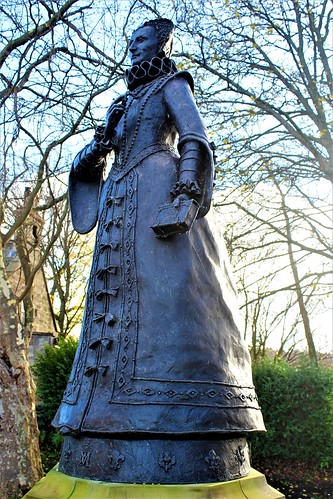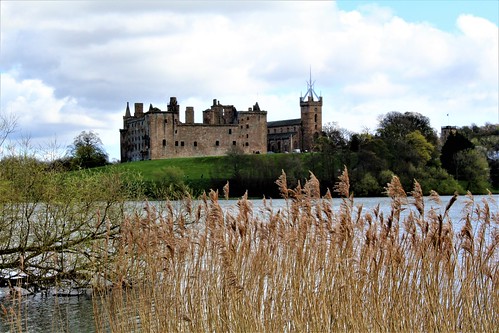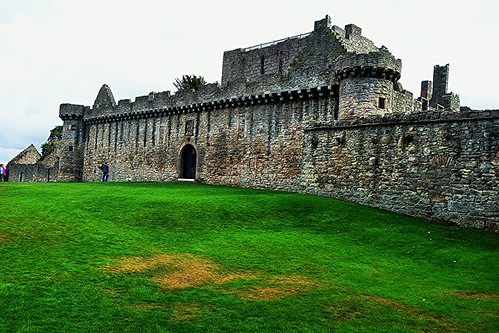Mary, Queen of Scots
(Above image is a capture of a statue of Mary at Linlithgow Palace.)
© Nigel P Cole/Catswhiskerstours Limited
Actress in high status costume of the day.Mary was born in the mid 16th century and directly thrust into a vortex of religious change and power politics, both intra-national and international. At just nine months of age Mary was crowned Queen of Scotland. At age 5 years was separated from her family and sent to France where she was brought up in the French Court in the Roman Catholic faith. Mary became Queen Consort of France in 1559 but was widowed within 18 months and returned to a Protestant Scotland in 1561 age 18 years with both parents dead. She resumed the throne of Scotland but entered into a disastrous marriage with Lord Darnley in 1565, a union which produced one son, the future James VI (Scotland) I (England). Darnley was murdered in 1567. That same year Mary married the Earl of Bothwell and became unpopular in the country. She was imprisoned and abdicated. Her son, James VI was crowned King of Scotland in July 1567 age 13 months. In May 1568 she escaped from her confinement but suffered a military defeat at the Battle of Langside, Glasgow that same month. Mary then fled south to England and was initially held at Carlisle Castle following which a eighteen year period of imprisonment/house arrest ensued culminating in her execution in 1587 at Fotheringhay Castle for plotting against Queen Elizabeth I.
Listed below are the key sites associated with Mary in approximate chronological order.
→Linlithgow Palace, near Edinburgh: Mary was born here on December 8th 1542 and christened at the nearby Kirk of St. Michael. Here she spent the first nine months of her life. Her mother was Marie de Guise (1515-1560), the French born second wife of King James V. The latter died six days after Mary’s birth.Linlithgow Palace is now a substantial ruin and open to the public. Located about fifteen miles west of Edinburgh.
→Stirling Castle in Central Scotland: Mary was crowned Queen of Scots at the Chapel Royal on September 9th 1543, age nine months. Mary’s mother, Marie de Guise, who ruled as Regent during Mary’s childhood, had a close association with this castle. Mary’s son, King James VI was christened here in 1566. The Royal Apartments there have been restored to their Renaissance grandeur to afford visitors a flavour for the style of Royal life in the 16th century.
→Dunkeld, in Central Scotland: Henry VIII of England embarked on a military campaign ( 1544-1549) to force the Scots to agree a contract for the marriage of his son, Edward and Mary. In May, 1544 Mary was moved to Dunkeld for safety by her mother. Mary visited Dunkeld again, in 1564. Dunkeld is a pleasant small town on the banks of the River Tay and is popular with visitors.
→Inchmahome Priory, Lake of Menteith: Mary was taken here for safety for a period of three weeks in late 1547 when age four years. The ruined Priory is located on an island in the middle of the lake and is accessed by small boat. Close to Aberfoyle in the popular Trossachs region of Scotland.
Lake of Menteith with Inchmahome Island in distance.
→Scottish Parliament Building: In 1548 the Scottish Parliament agreed to the betrothal of Mary and the Dauphin of France. This in context of the ‘auld alliance’ between Scotland and France. This ‘old’ Parliament building still exists and can be visited .It is located behind St, Giles Cathedral on Edinburgh’s Royal Mile.
King Charles II statue with Old Parliament in background.
→Dumbarton Castle, Firth of Clyde: Mary departed here for France at tender age of five years in 1548. Built on the stump of an ancient volcano and is open to visitors. Offers superb views over the River Clyde and Trossachs region.
→Palace of Holyroodhouse, Edinburgh: An important residence for Mary upon her return to Scotland. She engaged in robust debates on religion with Protestant firebrand, John Knox here in 1561. In 1566 her secretary, David Rizzio was murdered at Holyrood by Lord Darnley. A significant Royal palace today and open to visitors. It was reconstructed 1671-79.
→Dunbar Castle: Mary and Lord Darnley went here after the murder of David Rizzio in March, 1566. She visited the castle two further times in 1567, before and after her marriage to the Earl of Bothwell. Dunbar is located on the coast to the east of Edinburgh. This castle was once a mighty fortress but was demolished and now extends to unsafe ruins.
→Edinburgh Castle: It was in the Royal Apartments at Edinburgh Castle that Mary gave birth to the future King James VI, on June 19th 1566. Edinburgh Castle is one Scotland’s top visitor attractions.
→Craigmillar Castle: Located south of Edinburgh. It was here that Mary finalised the baptism arrangements for James in late 1566. A significant but accessible ruin.
→Hermitage Castle, Scottish Borders: In October 1566, Mary paid a brief visit to the Earl of Bothwell who was recovering here after suffering injury in combat. A stunning structure which is open to visitors.
→Traquair House, Innerleithen, Scottish Borders: Mary visited here in 1566. Open to visitors.
→Mary, Queen of Scots House, Jedburgh: Mary is reputed to have stayed at this fortified house during October 1566. Now a museum and open to visitors.
→Lochleven Castle, Kinross: Mary was imprisoned here in mid 1567 following her marriage to the Earl of Bothwell, a union which proved unpopular in the country. She signed papers of abdication at Lochleven and gave birth, ostensibly to stillborn twins. The castle is located on an island in the loch and accessed by boat. Open to visitors.
→Langside, Glasgow: Site of battle on May 15th 1568 which Mary’s forces lost. This occurred after Mary’s escape from Lochleven and as she was travelling to Dumbarton Castle.
→Dundrennan Abbey, Galloway: Mary stopped here in 1568 en-route to England after losing the Battle of Langside. The abbey is a ruin and open to visitors.
→Carlisle Castle, England: Mary was initially held here upon arrival in England in 1568. A major visitor attraction open to the public.



















Comments
Post a Comment